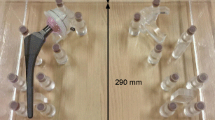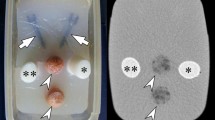Abstract
Metal artefacts pose a common problem in single energy computed tomography (SECT) images used for radiotherapy. Virtual monoenergetic (VME) images constructed with dual energy computed tomography (DECT) scans can be used to reduce beam hardening artefacts. Dual energy metal artefact reduction is compared and combined with iterative metal artefact reduction (iMAR) to determine optimal imaging strategies for patients with metal prostheses. SECT and DECT scans were performed on a Siemens Somatom AS-64 Slice CT scanner. Images were acquired of a modified CIRS pelvis phantom with 6, 12, 20 mm diameter stainless steel rods and VME images reconstructed at 100, 120, 140 and 190 keV. These were post-reconstructed with and without the iMAR algorithm. Artefact reduction was measured using: (1) the change in Hounsfield Unit (HU) with and without metal artefact reduction (MAR) for 4 regions of interest; (2) the total number of artefact pixels, defined as pixels with a difference (between images with metal rod and without) exceeding a threshold; (3) the difference in the mean pixel intensity of the artefact pixels. DECT, SECT + iMAR and DECT + iMAR were compared. Both SECT + iMAR and DECT + iMAR offer successful MAR for phantom simulating unilateral hip prosthesis. DECT gives minimal artefact reduction over iMAR alone. Quantitative metrics are advantageous for MAR analysis but have limitations that leave room for metric development.






Similar content being viewed by others
References
Mutic S, Palta JR, Butker EK et al (2003) Quality assurance for computed-tomography simulators and the computed-tomography-simulation process: report of the AAPM Radiation Therapy Committee Task Group No 66. Med Phys 30:2762–2792
Bar E, Cisek P, Cwikla J, et al (2014) SOMATOM sessions radiation therapy supplement. Siemens 24
Andersson KM, Nowik P, Persliden J et al (2015) Metal artefact reduction in CT imaging of hip prostheses—an evaluation of commercial techniques provided by four vendors. Br J Radiol 88:20140473
Hegazy MAA, Eldib ME, Hernandez D et al (2018) Dual-energy-based metal segmentation for metal artifact reduction in dental computed tomography. Med Phys 45:714–724
Goo HW, Goo JM (2017) Dual-energy CT: new horizon in medical imaging. Korean J Radiol 18:555–569
Giantsoudi D, De Man B, Verburg J et al (2017) Metal artifacts in computed tomography for radiation therapy planning: dosimetric effects and impact of metal artifact reduction. Phys Med Biol 62:R49–R80
Van Elmpt W, Landry G, Das M, Verhaegen F (2016) Dual energy CT in radiotherapy: current applications and future outlook. Radiother Oncol 119:137–144
Bamberg F, Dierks A, Nikolaou K et al (2011) Metal artifact reduction by dual energy computed tomography using monoenergetic extrapolation. Eur Radiol 21:1424–1429
Agrawal MD, Pinho DF, Kulkarni NM et al (2014) Oncologic applications of dual-energy CT in the abdomen. Radiographics 34:589–612
Simons D, Kachelrieß M, Schlemmer H-P (2014) Recent developments of dual-energy CT in oncology. Eur Radiol 24:930–939
Meyer E, Raupach R, Lell M et al (2010) Normalized metal artifact reduction (NMAR) in computed tomography. Med Phys 37:5482–5493
Meyer E, Raupach R, Lell M et al (2012) Frequency split metal artifact reduction (FSMAR) in computed tomography. Med Phys 39:1904–1916
Sheen H, Shin H-B, Cho S et al (2017) Feasibility of dual-energy computed tomography in radiation therapy planning. J Korean Phys Soc 71:1056–1063
Schwahofer A, Bär E, Kuchenbecker S et al (2015) The application of metal artifact reduction (MAR) in CT scans for radiation oncology by monoenergetic extrapolation with a DECT scanner. Z Med Phys 25:314–325
Bär E, Schwahofer A, Kuchenbecker S, Häring P (2015) Improving radiotherapy planning in patients with metallic implants using the iterative metal artifact reduction (iMAR) algorithm. Biomed Phys Eng Express 1:25206
Li H, Noel C, Chen H et al (2012) Clinical evaluation of a commercial orthopedic metal artifact reduction tool for CT simulations in radiation therapy. Med Phys 39:7507–7517
Morsbach F, Bickelhaupt S, Wanner GA et al (2013) Reduction of metal artifacts from hip prostheses on CT images of the pelvis: value of iterative reconstructions. Radiology 268:237–244
Wang F, Xue H, Yang X et al (2014) Reduction of metal artifacts from alloy hip prostheses in computer tomography. J Comput Assist Tomogr 38:828–833
Zhou C, Zhao YE, Luo S et al (2011) Monoenergetic imaging of dual-energy CT reduces artifacts from implanted metal orthopedic devices in patients with factures. Acad Radiol 18:1252–1257
Bongers MN, Schabel C, Thomas C et al (2015) Comparison and combination of dual-energy- and iterative-based metal artefact reduction on hip prosthesis and dental implants. PLoS ONE 10:1–12
Yagi M, Ueguchi T, Koizumi M, et al (2013) Gemstone spectral imaging: determination of CT to ED conversion curves for radiotherapy treatment planning. J Appl Clin Med Phys 14:173–186
Baron B, De Marzi L, Pierrat N (2017) Dual energy CT: iterative metal artifact reduction for radiotherapy. Phys Medica 44:29
Reft C, Alecu R, Das IJ et al (2003) Dosimetric considerations for patients with HIP prostheses undergoing pelvic irradiation. Report of the AAPM radiation therapy committee task group 63. Med Phys 30:1162–1182
Axente M, Paidi A, Von Eyben R et al (2015) Clinical evaluation of the iterative metal artifact reduction algorithm for CT simulation in radiotherapy Clinical evaluation of the iterative metal artifact reduction algorithm for CT simulation in radiotherapy. Med Phys 42:1170–1183
Katsura M, Sato J, Akahane M et al (2018) Current and novel techniques for metal artifact reduction at CT: practical guide for radiologists. Radiographics 38(2):450–461
Funding
No financial funding was provided for this study. An evaluation licence for iMAR was provided by Siemens, in part to perform this study.
Author information
Authors and Affiliations
Corresponding author
Ethics declarations
Conflict of interest
All author declares that they have no conflict of interest.
Ethics approval
This article does not contain any studies with human participants or animals performed by any of the authors.
Additional information
Publisher's Note
Springer Nature remains neutral with regard to jurisdictional claims in published maps and institutional affiliations.
Rights and permissions
About this article
Cite this article
Lim, P., Barber, J. & Sykes, J. Evaluation of dual energy CT and iterative metal artefact reduction (iMAR) for artefact reduction in radiation therapy. Australas Phys Eng Sci Med 42, 1025–1032 (2019). https://doi.org/10.1007/s13246-019-00801-1
Received:
Revised:
Accepted:
Published:
Issue Date:
DOI: https://doi.org/10.1007/s13246-019-00801-1




